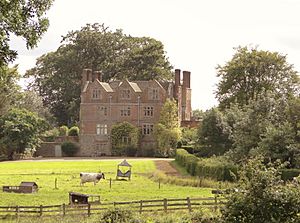Frances Stackhouse Acton facts for kids
Quick facts for kids
Frances Stackhouse Acton
|
|
|---|---|
| Born | Frances Knight 1793 Elton |
| Died | 24 January 1881 (aged 87–88) Acton Scott |
| Occupation | Botanist, artist, writer, scientific illustrator |
| Spouse(s) | Thomas Pendarves Stackhouse Acton |
| Parent(s) |
|
| Family | Thomas Andrew Knight, Charlotte Knight, Elizabeth Knight |
Frances Stackhouse Acton (born Knight; 7 July 1794 – 24 January 1881) was a talented British woman. She was known as Fanny and worked as a botanist, archaeologist, writer, and artist. Her father, Thomas Andrew Knight, was a famous botanist who encouraged her to learn and even included her in his science experiments.
After marrying an older landowner, and with no children of her own, Frances was able to follow her many passions when her husband passed away. These interests included studying ancient history and architecture. She even dug up and explored a Roman villa. She also designed and built new structures and helped save old buildings that needed fixing. Frances loved to paint buildings and later published a book called The Castles & Old Mansions of Shropshire to raise money for charity.
Contents
Early Life and Family
Frances Knight, also known as Fanny, was born on July 7, 1794. Her birthplace was Elton Hall, near Elton, Herefordshire. Her parents were Thomas Andrew Knight, a well-known botanist, and Frances Knight. Her mother's family owned the Elton estate.
Fanny was the oldest daughter in her family. She had two younger sisters, Elizabeth and Charlotte, and a brother named Thomas. Around 1808, her family moved to Downton Castle in Herefordshire. This castle was built by her great-grandfather and was owned by her uncle, Richard Payne Knight.
Fanny's father strongly believed in education for all his children. She remembered spending many happy hours with him. They would be in his study or working in his garden.
In January 1812, when Fanny was 18, she married Thomas Pendarves Stackhouse. He was 43 years old. Their wedding took place at Old Downton Church in Downton. The couple moved into Acton Scott Hall. This hall belonged to Thomas's mother, but it was in poor condition.
When Thomas's mother died in 1834, he inherited Acton Scott Hall. The couple then became known as Mr. and Mrs. Stackhouse Acton. Sadly, her husband died the next year. Since they had no children, Frances Stackhouse Acton inherited his entire estate.
Frances's Many Interests
Frances Stackhouse Acton was only 40 years old when her husband passed away. Because she had no children, she was free to explore her many interests. She was curious about many different things.
Botany and Art
Frances's father, a famous botanist, encouraged her love for plants. She often helped him with his plant experiments. These experiments took place in the gardens of Downton Castle.
She used her artistic skills to illustrate two of her father's books. She drew three pictures for Pomona Herefordiensis. Seventy years later, she also contributed apple drawings to Herefordshire Pomona. People thought she was a very skilled botanist and artist. She even inspired her cousins, Emily and Charlotte, to paint plants too.
Archaeology and Discoveries
A Roman villa was found on the land of Acton Scott Hall. In 1844, Frances Stackhouse Acton led the excavation of this villa. She also found many other Roman artifacts. She wrote detailed letters about her findings to the Dean of Hereford.
The building seemed to be a large barn, about 31 meters long and 12.5 meters wide. It had been changed into a house. It even had rooms heated by a hypocaust, which was likely a Roman bathhouse. Frances drew detailed maps of the villa, showing the heating system. Later, she even rebuilt part of the hypocaust system in a nearby quarry. In 2009, another investigation found evidence of the villa. However, it was not exactly where Frances had described it.
Passion for Buildings
Frances Stackhouse Acton loved buildings, especially old ones. She often painted historical places like old abbeys and grand homes. She sometimes left the people or animals in her paintings unfinished.
She worked hard to repair many small houses on her estate. She also built a school for the local children. In the quarry where she rebuilt the hypocaust, she created a secret garden. Near this garden, she built a chalet in the style of a Swiss house. Frances also spent time improving Acton Scott Hall. She replaced and made windows bigger. She also added beautiful 17th-century wooden details to the hall.
She was very interested in Stokesay Castle. By the early 1800s, this castle was falling apart. In 1853, she convinced the owner, William Craven, to pay for its repair. She supervised the restoration herself. The cost was over £100, which was a lot of money back then. She managed to "clear out and secure" the castle. However, she could not stop it from falling apart completely. Eventually, the castle was sold.
Writing and Publications
After her father died, his family wanted his complete works to be published. Frances Stackhouse Acton gathered his papers. She also wrote a short story about his life called "Sketch of his life" for the introduction.
Frances also wrote an important book called The Castles & Old Mansions of Shropshire. All the money from this book was given to charity. It went to the Royal Salop Infirmary and the Eye and Ear Dispensary. The Shropshire Archaeological and Natural History Society later said the book was "very valuable."
Legacy
Frances Stackhouse Acton passed away on January 24, 1881, in Acton Scott. She was 86 years old. Her obituary, a notice about her death in The Gardeners' Chronicle, mentioned her wide knowledge. It said she knew a lot about geology, plants, gardening, and ancient history.
See also
 In Spanish: Frances Stackhouse Acton para niños
In Spanish: Frances Stackhouse Acton para niños


